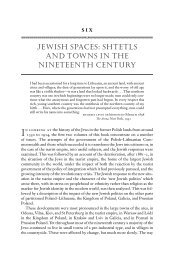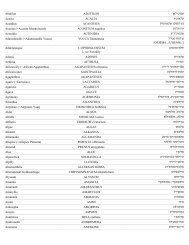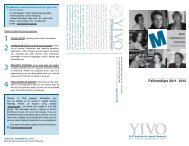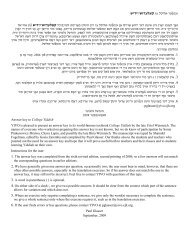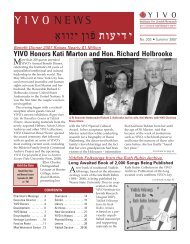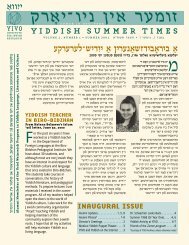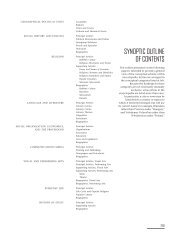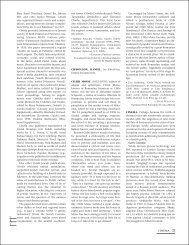t any plant names in Yiddish - YIVO Institute for Jewish Research
t any plant names in Yiddish - YIVO Institute for Jewish Research
t any plant names in Yiddish - YIVO Institute for Jewish Research
Create successful ePaper yourself
Turn your PDF publications into a flip-book with our unique Google optimized e-Paper software.
XXIV<br />
˘È„”È Ôȇ ËÏÚÂÂ≠ÔÒ˜ÈÂÂÚ‚ È„ Ÿ ¯ÚËÎÚ˘ È΄¯Ó<br />
were the Argent<strong>in</strong>ian Kolonist (Dom<strong>in</strong>guez-Entre Rios, 1916-7) and Kolonist<br />
kooperator (Buenos Aires, 1917-76), 10 but especially Yidisher landvirt<br />
(Warsaw, 1928; Lviv, 1933-9), Birobidzhaner shtern (Birobidzhan, 1930-),<br />
Kolvirt-emes (Kal<strong>in</strong><strong>in</strong>dorf, 1930-5), Kolvirt-shtern (Nay-Zlatopolye, 1931-6),<br />
Bahershn di tekhnik fun der sotsyalistisher landvirtshaftlekher produktsye<br />
(Kharkov, 1932-4), and the last 10-12 years of Der yidisher farmer (New<br />
York, 1908-59). 11<br />
Agricultural handbooks and other sources<br />
In the 20th century, garden<strong>in</strong>g became a popular pursuit <strong>for</strong> some city<br />
dwellers who owned patches of suburban land. (Keep<strong>in</strong>g orchards had become<br />
popular earlier, <strong>in</strong> the 19th century.) Courses <strong>in</strong> garden<strong>in</strong>g were offered<br />
both by the O.R.T. (Organization <strong>for</strong> Rehabilitation through Tra<strong>in</strong><strong>in</strong>g)<br />
and by the agricultural schools run by the <strong>Jewish</strong> Colonization Association<br />
(J.C.A.) <strong>in</strong> eastern Galicia, Bessarabia, and elsewhere.<br />
An important role <strong>in</strong> assist<strong>in</strong>g <strong>Jewish</strong> agriculturists and gardeners to<br />
learn their new trades was played by agronomists through the handbooks<br />
they published. These were <strong>in</strong>strumental <strong>in</strong> the enrichment of <strong>Yiddish</strong> botanical<br />
term<strong>in</strong>ology. Thus, Raseyn's handbook of garden<strong>in</strong>g (1939) lists<br />
m<strong>any</strong> dozens of vegetable varieties <strong>in</strong>clud<strong>in</strong>g, <strong>for</strong> example, eight varieties<br />
of potatoes, among them friike roze, zeks-vokhedike, etc. Even richer is a<br />
handbook on orchard-keep<strong>in</strong>g (Leyk<strong>in</strong> 1935): it gives a good description<br />
and advice on cultivat<strong>in</strong>g 32 commercial varieties of apples (1935: 75-81),<br />
27 varieties of pears (1935: 81-5), and 15 varieties of plums (1935: 85-8).<br />
Two additional figures shed light on the statement about the role of<br />
agronomists. Some garden varieties of fruits and vegetables, of course,<br />
were known <strong>in</strong> <strong>Yiddish</strong> <strong>in</strong> the 19th century and probably much earlier. The<br />
fact that, <strong>for</strong> <strong>in</strong>stance, I. Rab<strong>in</strong> (1968: 77) can list <strong>in</strong> his memoirs – <strong>in</strong> one<br />
breath – ten varieties of apples (antón, anís, hóznkep, váynike, tsigánkes,<br />
pép<strong>in</strong>kes, váyser alív, shampányer, sháfran, apórt) and five varieties of<br />
pears (dushésn, bergamótn, béres, smólkes, sapozhánkes) attests to their<br />
popularity. In my Plant Names <strong>in</strong> <strong>Yiddish</strong>, (Schaechter 1994), I list (with<br />
their sources) 240 (two hundred and <strong>for</strong>ty) varieties, <strong>in</strong>clud<strong>in</strong>g synonyms<br />
and variants of pears and 189 (one hundred and eighty n<strong>in</strong>e) varieties of<br />
apples. M<strong>any</strong> of these varieties, as well as varieties of other fruits and vegetables,<br />
were culled from <strong>in</strong>terviews with <strong>Yiddish</strong> speakers, but most were<br />
drawn from the <strong>Yiddish</strong> agricultural handbooks written by agronomists<br />
(Borovitsh 1927, Dobrolyubov-Gitman 1933, Dobzh<strong>in</strong>ski 1934-8, Kamenetski<br />
and Tsegelnitski 1920, Kolodni 1919, 1921, Leyk<strong>in</strong> 1935, Raseyn 1939,<br />
Tretyakov 1933, Veler 1900, etc.) or memoirs (such as those of Hirsh<br />
10) After 1976, with the demise of its last <strong>Yiddish</strong> editor, A. Gabis, it became a Spanishlanguage<br />
publication.<br />
11) Particularly under the guidance of its last editor, L. Berman.



